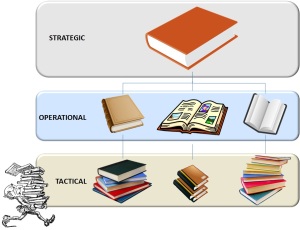I’ve been working in some way or fashion in the field of quality consulting since about 1990 when I attended one of my first Total Quality Management courses at Carswell AFB in Ft Worth TX. Since then I have worked in the areas of strategic planning, strategic communication, performance management, process management, human capital planning, resource management, and education and training. I’ve been in the lowest tactical to the highest CEO positions of military, non-profits, and companies and seen many things both doing and consulting in these areas.
So what?
Over the last several years I’ve been really thinking about what makes companies successful. My upcoming book, Overcoming Organizational Myopia is based on a lot of that thought. What I see too much of is organizations looking for that silver bullet. I was in a recent meeting, where a leader said he was looking for that one single metric that when tugged upon it unravelled everything else going on in the organization. My answer would be really simple, that doesn’t exist. Being a top performing (you fill in the blank) takes a lot of work and it’s constant work.
The group I work for now has been extremely successful over the last two years. My boss is even going to be interviewed by Gallup because of their employee engagement success in their last UCount survey. One of the managers in the team commented that now we have to sustain it. My response was, no, now we have to make it better next year. In today’s day and age, sustaining is the death of a company. You have to get better. When I started with them in January of 2012, they had just won The Keepers of Quality award for their major organization. That was great, but there was a lot more they could do. This month, we share part of our two-year continuous improvement story with that sMe audience to discuss how we are building and encouraging an environment of continuous improvement–quality.
What is all this mean?
High performing organizations don’t just “happen.” It takes. Lot of hard work and it’s a constant journey. If you read business books like I do, you probably heard many ways to become that high performing organization. They tell you what it is, they tell you what you should do, and they tell you why. They fill your head with fantastic stores of Apple and Dell, turn arounds like IBM and Harley Davidson, etc. trust me, I have read them all–well a lot of them. The thing they don’t tell you is HOW.
Funny, there are so many How To and Self Help books on the shelf, but none give away the secrets to becoming a great organization. How To books sell too–my speech writing instructor and mentor, Joan Detz taught me that in 2005.
So, how does an organization really improve? That’s the thoughts that have been on my mind of late. My soon to be released book focuses on part of the story, overcoming the “silo effect” that plagues every business in the world. You know what I’m talking about…sand boxes, camps, teams…the way we organize and the way we group as human beings lead us to form silos–we become myopic in business. They problem is that it will ALWAYS happen–you can’t avoid it. Leaders and managers alike might recognize it and try to break it down, but it happens to all of us. Overcoming Organizational Myopia is a true how to book focused on the nine things that suffer in siloed organizations and how to overcome it–not solve it, but to overcome it.
But the key, I think is the “Golden Egg,” as James Farhat would say. That is how does any organization that wants to be high performing make it happen? If they were a car, how do they get their engine firing on all cylinders? That is my journey this year. My effort in 2014 is to not only define it, but to lay out the roadmap and provide holistic training to all, at whatever level they are at, to help them become better and grow.
A guy I worked with in Booz Allen used to comment about how the different teams in our office would fight over the pieces of the “pie.” He was talking about this perceived limited amount of money that was available to all of Booz Allen that we would fight to get a piece of. He believed that believing that the pie was a certain size was limiting our ability to go for more and this we had to take more of someone else’s pie to grow our own silo–back to the myopia view again.
In America today, I think many business look at the perceived pie and think they have to take from others to get a bigger share. That leads us to disruptive innovation, aggressive marketing, and like tactics to win over the market share pie. What if I told you that the pie doesn’t exist. The better you are as a high performing organization, the more people will buy your whatever? I believe that doing good work gets more work–it’s not about pies, but about becoming the best at what you do. This is true both of an organization and as an individual.
So, I leave you with these thoughts on this Tuesday morning. Myopia, pies, and high performing organizations. Let me know what you think. Tell me it can’t be done…that I don’t know what I’m talking about. I look forward to the debate.
For those interested, what does a high performing organization mean to you?




 Proper Strategic Planning is the Most Important First Step for Any Organization
Proper Strategic Planning is the Most Important First Step for Any Organization